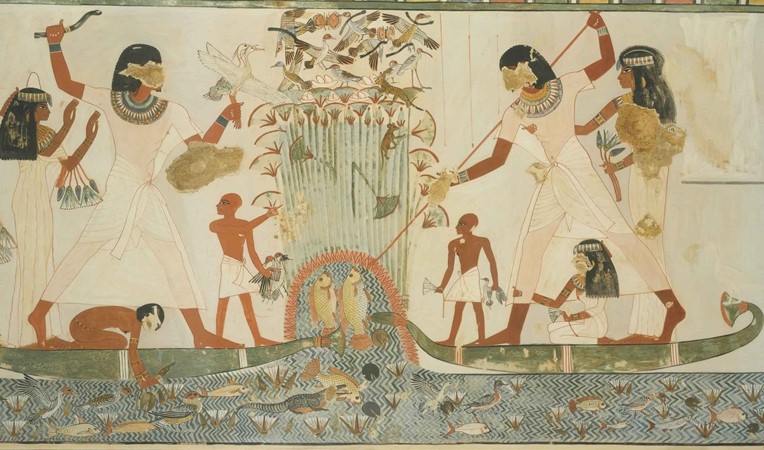Fishing
is an ancient practice that dates back, at least to the Upper Paleolithic
period, which began about 40,000 years ago. Isotopic analysis of the skeletal
remains of Tianyuan man, a 40,000-year-old modern human from eastern Asia, has
shown that he was, regularly, consuming freshwater fish. Archaeological
features such as shell middens, discarded fish bones and cave paintings, showed
that sea food, was important for survival and consumed in significant
quantities. During this period, most people lived a hunter-gatherer lifestyle
and were, of necessity. However, where there are early examples of permanent
settlements such as those at Lepenski Vir, they are almost always associated
with fishing as a major source of food.
After
several investigations and researches done, proved that fishing methods routed
from the ancient Egyptians civilization. Egypt can be defined as the bedrock of
fishing, because the Egyptian civilization at the time has been one of the
first to introduce this practice in the world. Fish were very abundant in
Egypt, as Egypt is located on both the Mediterranean and Red Seas, along with
the river Nile. Fishing was typically practiced on the river Nile, either by
nets from a boat, using dragnets from shore or using bow nets in narrow banks
of the river. On the other hand, fishing was also practiced as a sport for
pleasure. Spear fishing and angle fishing were two types of fishing as a sport
that required a lot of patience and skill.
Fishing,
also called angling, the sport of catching fish, freshwater or saltwater,
typically with rod, line, and hook. Like hunting, fishing originated as a means
of providing food for survival. Fishing as a sport, however, is of considerable
antiquity. An Egyptian angling scene from about 2000 BCE shows figures fishing
with rod and line and with nets. A Chinese account from about the 4th century
BCE refers to fishing with a silk line, a hook made from a needle, and a bamboo
rod, with cooked rice as bait. References to fishing are also found in ancient
Greek, Assyrian, Roman, and Jewish writings. There were 2 common methods of
fishing: Angling and Spearing.
The
history of angling is in large part the history of tackle, as the equipment for
fishing is called. One of humankind’s earliest tools was the predecessor of the
fishhook: a gorge—that is, a piece of wood, bone, or stone 1 inch (2.5 cm) or
so in length, pointed at both ends and secured off-center to the line. The
gorge was covered with some kind of bait. When a fish swallowed the gorge, a
pull on the line wedged it across the gullet of the fish, which could then be
pulled in. Similar to modern fishing, angle fishing was a very common
fishing technique, which requires a hook, however, no fishing rods were used at
the time, instead, thick hand lines. Angling was mostly practiced among
commoners and not upper class Egyptians. it was an important means of obtaining
food. The picture evidence available does not show upper-class people
practicing angling. However, usually the pictures display commoners using
angling to fish from a boat, with their masters watching. Evidence of the first
fishing rod appears in the Middle Kingdom period, in the tomb of Beni Hassan.
With
the advent of the use of copper and bronze, a hook was one of the first tools
made from metal. This was attached to a hand-operated line made of animal or
vegetable material of sufficient strength to hold and land a fish. The practice
of attaching the other end of the line to a rod, at first probably a stick or
tree branch, made it possible to fish from the bank or shore and even to reach
over vegetation bordering the water.
For
over a thousand years, the fishing rod remained short, not more than a few feet
(a meter or so) in length. The earliest references to a longer, jointed rod are
from Roman times, about the 4th century CE. As with the earliest rods made from
streamside branches, the first longer rods were made of wood, which would
continue as the dominant rod material well into the 19th century.
Spear
fishing with barbed poles (harpoons) was widespread in Paleolithic times. It
was a demanding and challenging method of fishing, that requires certain
attributes in the hunter, as patience to decoy the fish and a certain amount of
accuracy to end up with a well-aimed throw. Spear fishing, in ancient Egypt,
had greater value as a sport than angling did. Originally, in pre-historic and
early times, spear fishing only served to provide food, and then it evolved
into a recreation for the upper class. According
to archaeological evidence, spears used in sports could be divided
into three types; spears with a single head, two headed spears and harpoons.
Over-fishing (via
net-fishing) and illegal fishing methods, continues to destroy the Red
Sea's ecosystems, endangering coral reefs and all the marine life. Among
the most recent efforts to combat over-fishing in Egypt's Red Sea, is the
Hurghada Declaration. It was suggested, done and signed, in June 2009 , by the
Hurghada Environmental Protection and Conservation Association (HEPCA), in
cooperation with the Red Sea Governorate, the South Sinai Governorate, and the
Suez Governorate, along with the Ministries of Agriculture and Environment.
This declaration of principles, aims to ban all net-fishing and trawling in the
Red Sea, with the exception of the area north of the Gulf of Suez.












 All
All
 Politics
Politics
 Economy
Economy
 Tourism
Tourism
 Nature
Nature
 Community
Community

